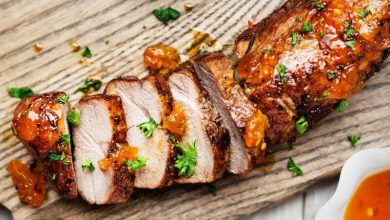🍖🍞🍅😋 Meatloaf: A Hearty Classic! 🍽️👨🍳
What is Meatloaf?
Meatloaf is a beloved comfort food dish made from ground meat, typically beef, though variations using pork, veal, or a mix of meats are common. It’s mixed with various ingredients like breadcrumbs, seasonings, and often vegetables or herbs, then baked in a loaf shape. Once sliced, it reveals a tender and flavorful interior, making it a staple in American cuisine.
History of Meatloaf:
The origins of meatloaf can be traced back to Europe, where similar dishes have been made for centuries. However, it gained popularity in the United States during the Great Depression, as it was an economical way to stretch meat supplies. Over the years, it has evolved into a versatile dish with countless regional and personal variations.
Components of Meatloaf:
- Ground Meat: Typically beef, but variations use pork, veal, turkey, or a blend.
- Binders: Breadcrumbs or oats help hold the loaf together.
- Aromatics: Onions, garlic, celery, and herbs add flavor.
- Liquid: Eggs and milk bind the ingredients and keep the meatloaf moist.
- Seasonings: Salt, pepper, and other seasonings like Worcestershire sauce or soy sauce for depth of flavor.
- Toppings/Sauces: Some people top meatloaf with ketchup, barbecue sauce, or gravy.
Steps to Prepare Meatloaf:
-
Gather Ingredients: Collect all the necessary components listed above.
-
Mix Ingredients: In a large mixing bowl, combine the ground meat, breadcrumbs, finely chopped onions, garlic, celery, herbs, eggs, milk, and seasonings. Mix until everything is evenly incorporated.
-
Shape the Loaf: Form the meat mixture into a loaf shape and place it in a baking dish. You can shape it freehand or use a loaf pan.
-
Toppings: Spread a layer of ketchup, barbecue sauce, or your preferred topping over the meatloaf for extra flavor and a nice glaze.
-
Bake: Preheat your oven to 350°F (175°C) and bake the meatloaf for about 1 hour or until it reaches an internal temperature of 160°F (71°C). You can also insert a meat thermometer into the center to check doneness.
-
Rest: Let the meatloaf rest for a few minutes before slicing to allow the juices to redistribute.
Total Time Needed:
- Preparation: 20 minutes
- Baking: 1 hour
- Resting: 10 minutes
In total, you can expect to spend approximately 1 hour and 30 minutes from start to finish.
Now, you’re ready to enjoy a classic meatloaf! 🍽️👌 Serve it with mashed potatoes and your favorite vegetables for a hearty, comforting meal. 😊🥔🥕
Certainly! Here are some nutrition facts and health information for a typical meatloaf recipe:
Nutrition Facts (Approximate values per serving):
- Calories: 300-400 kcal
- Protein: 20-30 grams
- Fat: 15-20 grams
- Carbohydrates: 15-20 grams
- Fiber: 1-3 grams
- Sugar: 2-5 grams
- Sodium: 500-800 mg
Please note that these values can vary based on the specific ingredients and portion size used in your meatloaf recipe.
Health Information:
-
Protein: Meatloaf is a good source of protein, which is essential for muscle health and overall body function.
-
Fat: It contains moderate amounts of fat, which can vary depending on the meat used. Leaner meats like turkey or chicken can reduce the fat content.
-
Carbohydrates: The carbohydrates come from breadcrumbs and vegetables. Meatloaf is not a high-carb dish.
-
Fiber: While not a significant source of fiber, if you include vegetables in your recipe, it can provide some dietary fiber.
-
Sodium: Be cautious about the sodium content, especially if you use canned or processed ingredients like breadcrumbs, sauces, or seasonings. Consider using low-sodium options.
-
Nutrient Variability: The nutrient content can vary widely based on ingredients and portion size. For a healthier meatloaf, choose lean meats, whole-grain breadcrumbs, and plenty of vegetables.
-
Serving Size: Pay attention to your portion size, as it can significantly impact the overall nutritional intake. Smaller portions can be healthier if you’re watching your calorie intake.
-
Healthier Options: You can make meatloaf healthier by using leaner meats, adding more vegetables, and reducing added sugars and sodium in sauces and toppings.
Remember that the nutritional value can vary based on your specific recipe and ingredient choices. It’s a versatile dish, and you can adjust it to meet your dietary preferences and health goals.




